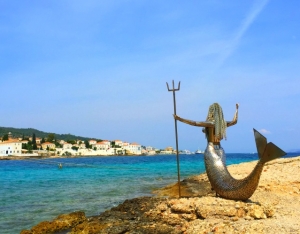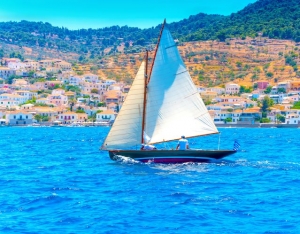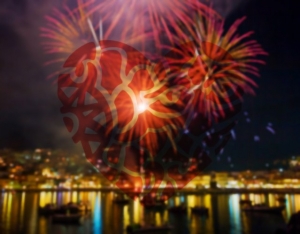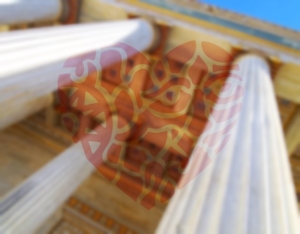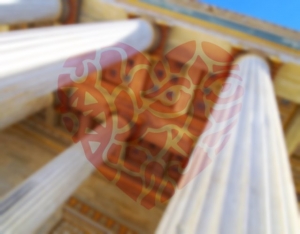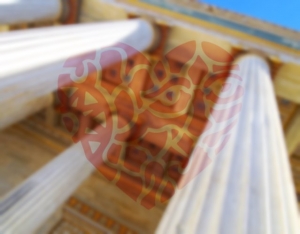Thodoris Bgenopoulos
Based on archaeological findings Spetses were first inhabited probably the third millennium BC.
Spetses in antiquity were called Pityonisos and Pityousa because of the many pine trees the island had. The Franks, from whom it takes its current name, called it "di Izola spezia" or "Izola du spezia , which meant island of aroma.
The island is conquered by the Henets right after the Franks, and then the Turks follow. The original medieval settlement of Spetses was in today's Kastelli area. The modern city was built in the late 18th century.
Spetses in 1770 join the struggle of the rest of Greece to gain their independence. In 1821 Spetses is one of the first islands, along with Hydra and Psara that raised the flag of the revolution and thanks to their large commercial fleet, played a key role in the fight. At the time some fighters from Spetses became distinguished. The most known are Laskarina Bouboulina, Chatzigiannis Mexis and Kosmas Barbatsis, who accomplished heroic deeds like the burning of the Turkish Armata. The commercial fleet of Spetses was until then a source of revenue for the island, but after the revolution it was driven in slow decline and its population was decreased.
Spetses begin to rise again in the early 20th century thanks to the national benefactor Sotirios Anargyros. Thanks to his vision to promote the island, his several projects, like the Poseidonio and Anargyrios Korgialenios School, give Spetses a new life.
This effort is accomplished with the rapid development of tourism that converts the island into the cosmopolitan tourist destination it is today.
Spetses is one of the most known island of Argosaronikos. It is a top touristic destination for vacations and thats exactly how the approximately 4.000 residents of the island multiply each summer. The island's length is over 22 square km The capital is the city of Spetses( or simply Spetses ), which is located on its west part, while the island Spetsopoula is also under its administration. During the 20th century tourism in Spetses gradually evolved, attracting thousands of visitors in the island and thus converting it to a cosmopolitan destination ideal for vacations.
Spetses is almost at the entrance of Argolikos Gulf, in a short distance from the Peloponnesean shores (Porto Heli, Costa), while in the east there is the island of Hydra. Spetses has the shape of an egg with max.length 4 square km and width 2.5. The island is mainly pine, although due to fires less than in the past, and a vast part is being cultivated. The highest peak of the island is Prophet Elias, with 245m height.
The climate is Mediterranean and cool, the best for vacations In the past, residents were intensively involved in marine and fisheries, something also carried out today, even though in a lesser extent due to the great focus on tourism.
Each year in Patras, in the region of Achaea, the famous Patrino Karnavali is being organized.
The Patras Carnival or Patrino Karnavali, as it is widely known in greek, is the biggest carnival in Greece, concentrating hundreds of thousands of people that take place in it or are just visiting. Its starting point is considered to be the first carnival dance that followed the Greek Revolution and was organized in 1829 in Patras. The Carnival of Patras (Patrino Karnavali) starts every year on 17 January and ends on Clean Monday.
The Carnival of Patras (Patrino Karnavali)is not just a carnival parade but a huge cultural event, and it is no exaggeration to say that the entire Patras lives at its pace.
Throughout the Patras Carnival numerous events are being organized. Dances, treasure hunt, carnival for the young, the Bourboulia, theatrical performances, concerts, exhibitions, cinema tributes etc. The climax is reached in the last weekend of the Carnival, with the Saturday night parade of the masqueraded and the spectacular parade of both the masqueraded and the chariots/floats on Sunday, which is topped with the ritual burning of the King Carnival (vasilias karnavalos) in the port of Patras.
Once the Carnival of Patras is over, the masqueraders and all those taking part in it, do not fall into melancholy as one might expect, but rather already begin to think about next year's uniforms and topics.
Patras Carnival (Patrino Karnavali) is a must-lived experience even for once. Take special care though to make your reservations on time, since during the Carnival days Patras literally "sinks" from the thousands of visitors.
More information about the Carnival of Patras-Patrino Karnavali you can find inwww.carnivalpatras.gr and the number 2610 390921.
Achaea, like every other place in Greece, maintains its own traditions and customs, which visitors have the chance to get to know through various events.
The most notable event-institution that has made Patras worldwide famous, is the Carnival of Patras or to put it in greek: Patrino Karnavali. Many things have been said about it, but none can truly describe it. You simply have to experience it.
Easter in Achaea, as throughout Greece, is a once in a lifetime experience not to be missed. The procession of the Epitaph, the Resurrection of Christ with the following fireworks and of course the Eastern table, will undoubtedly remain deeply etched in the memory of every visitor.
Apart from the Carnival of Patras, there are many more festivals and celebrations mainly religious, yet full of dancing, singing and feasting. Some of them are:
- 15th of August , the day of the Virgin Mary, in many places in the entire Achaea
- 14th of September, the day of the Cross, in Kato Achaea
- 30th of November, St Andrew's day in Patras, which is an official holiday for the city
Last but not least, is the most important event, which unfortunately is no celebration at all. It takes place on December 13th in Kalavryta, to honor the memory of all the people that had a terrible death in the appalling Massacre of Kalavryta.
The Archaeological Museum of Aigio is situated in the namesake region of Achaea, Aigio.
The Archaeological Museum of Aigio was inaugurated in 1994. It is housed in a building of 1890 that used to be the old city municipal market and is probably designed by the renowned German architect Ernst Ziller
The Archaeological Museum of Aigio includes findings from both the town of Aigio and other ancient cities of the wider area (Aigeira, Kyrenia, Rhypes etc.).
Among the exhibits, dating from the Neolithic to the Late Geometric period, what stands out is a large and strikingly beautiful statue depicting probably Jupiter.
In the patio of the Archaeological Museum of Aigio various cultural events are hosted.
Archaeological Museum of Aigio: Address, Agiou Andrea & Michalakopoulou, Aigio.
More information about the Archaeological Museum of Aigio you can find on the number 26910 21517.
The Municipal Museum of the Kalavritan Holocaust is situated opposite to the Cog Railway station.
The Municipal Museum of the Kalavritan Holocaust was inaugurated in 2005 and is housed in a building that used to be the primary school of Kalavryta. The visitor has the opportunity to learn about the Massacre of Kalavryta and see with his own eyes the terrible results of war.
Municipal Museum of the Kalavritan Holocaust: Address, A.Sygrouu street 1-5,Kalavryta.
More information concerning the Municipal Museum of the Kalavritan Holocaust can be found in www.dmko.gr and the number 26920 23646.
The Press Museum is located in Patras.
The Press Museum was founded in 1956 from the Association of Journalists of Peloponnese, Epirus and the Islands (ESIEPIN). The aim of the museum is the collection of newspapers, magazines and any kind of printed matter. Among others it features:
- Hundreds of newspaper headlines covering the period from 1815 until today
- Hundreds of magazine titles covering the period from 1852 until today
- Manuscripts and artefacts of the Revolution of 1821 and the early years of the Greek State
The Press Museum is a treasure trove of knowledge for every researcher and an interesting destination for every visitor.
Press Museum of Patras: Address, Maizonos 200,Patras.
More information concerning the Press Museum in Patras you can find inwww.mouseiotipou.gr and the number 2610 310488.
The Historical and Ethnological Museum is housed in the Literature and Art Palace, in the square of Vasileos Georgiou in Patras.
The Historical and Ethnological Museum was founded in 1973 by Ioannis Meletopoulos and Theodoros Papapanagiotou. Among the exhibits are historical relics of the Achaea region, with emphasis on the period of the Greek Revolution of 1821.
Historical and Ethnological Museum of Patras: Address, Vasileos Georgiou square, Patras.
More information about the Historical and Ethnological Museum can be found on the number 2610 274962.
The Archaeological Museum of Patras is situated just in the entrance of the city, at the New National Road Athinon-Patron.
The Archaeological Museum of Patras was inaugurated in 2009 and is housed in an area of 28 000 square meters, of which 8000 are taken up by the facilities.
The museum has three halls for its permanent exhibitions, each of which has a different theme. These are the hall of private life, the hall of the necropolis and the hall of public life. Through the thousands of the artifacts found in these rooms, the visitor can travel in time and reach ancient Patras, be a part of the old everyday life and see the burial habits of the time.
Also the Archaeological Museum of Patras features another room that hosts temporary exhibitions, a shop and an auditorium of 140 seats.
Archaeological Museum of Patras: Address, Nea Ethiniki Odos Patron-Athinon 38-40, Patras.
More information concerning the Archaeological Museum of Patras you can find in http://www.artasmuseum.gr and the number 2610 420645.
The Apollo Theater is situated at the Vasileos Georgiou square in Patras.
The Apollo Theater was built in 1872 with the designs of the leading architect Ernst Ziller. The theater is a miniature of the famous La Scala of Milan and for its construction the best materials of the time were used. The theater has an arena of 156 seats and 53 boxes.
The Apollo Theater is the oldest of the only three neoclassical theaters that are preserved in Greece (the other two being the namesake Apollo Theatre in Syros and Malliaropoulio in Tripoli). Today the Apollo Theater is home to the Municipal Regional Theatre (DI.PE.THE.) Patras and hosts numerous other cultural events.
Apollo Theater: Address, Vasileos Georgiou square 17, Patras.
More information about the Apollo Theater can be found via the number 2610 273613.

